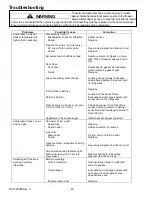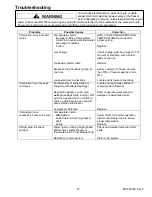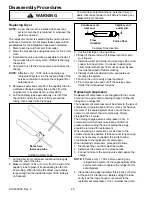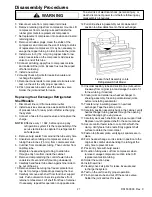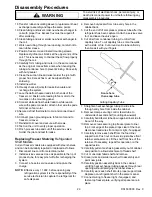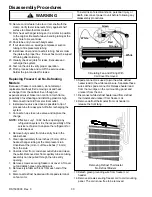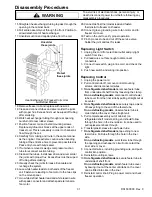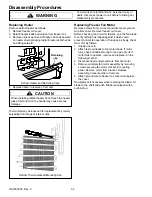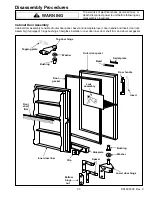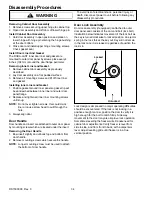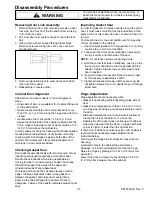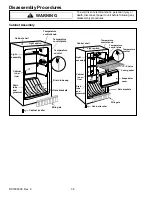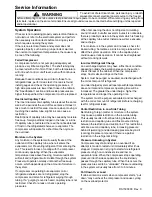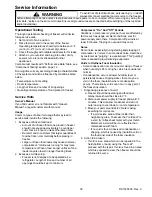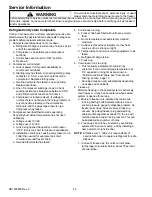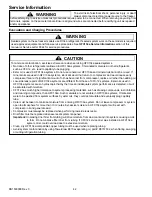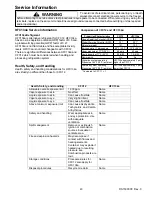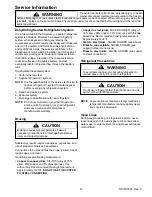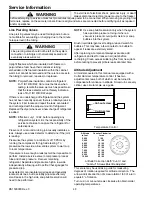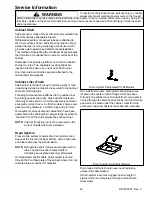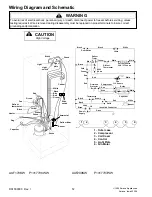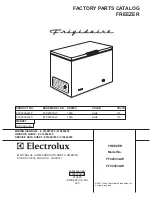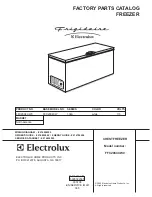
RS1500000 Rev. 0
38
Service Information
To avoid risk of electrical shock, personal injury, or death,
always disconnect electrical power source to the freezer
before attempting to service unless test procedures require power to be connected. When removing any wiring from
terminals, replace on the same terminals. Ensure all ground wires are connected before certifying unit as repaired
and/or operational.
WARNING
!
Checking Operating Pressures
If refrigeration system is not operating properly, check
operating pressures.
Install a piercing valve on compressor process tube and
on high side process tube.
NOTE:
Piercing valve should not be left on the tubing
after tests are complete. Remove the valve from
discharge line and repair the opening. Evacuate
and recharge the system.
When using gauges to verify operating pressures,
observe the following precautions.
1. Verify gauges are accurately calibrated. When not
connected into a system, gauge pointers should
indicate 0 pressure. If necessary, turn the
recalibrating screw on the dial until the pointer
indicates 0.
2. Verify temperature control is set to normally maintain
a 0°F (-17°C) temperature.
3. Remove all unfrozen food from the freezer.
4. Before taking final gauge readings, allow freezer to
run through several cycles with the door closed. This
will allow the temperature and pressures to stabilize.
5. Compare the final gauge readings for the model
being serviced, see the category which applies to the
readings indicated.
High Side
near normal pressure
Low Side
lower pressure (possible vacuum)
Wattage
lower than normal
Freezer shelf tubing or other low side tubing is probably
restricted (kinked or blocked with foreign particle). This
condition is usually accompanied with a frost build-up on
the low side of the restriction. High side pressures will
not unload and balance with the low side within the
prescribed seven to ten minutes after the compressor is
stopped.
High Side
low pressure
Low Side
lower pressure (possible vacuum)
Wattage
lower than normal
Indicates a leak in the high side of the system. Both
gauges will show progressively less pressure.
High Side
much higher pressure
Low Side
slightly
lower pressure
Wattage
higher than normal
Indicates a leak in the low side of the system. High side
pressures will continually increase drawing through the
leak becoming trapped in the high side tubing. Low side
gauge will show a slight pressure being drawn in through
the leak.
High Side
lower pressure
Low Side
lower pressure (possible vacuum)
Wattage
lower than normal
Indicates restriction at the entrance of the capillary tube.
High side pressures will take much longer than the
prescribed seven to ten minutes to unload and balance
with the low side after compressor has stopped.
High Side
higher pressure
Low Side
higher pressure
Wattage
higher than normal
Indicates an overcharge of refrigerant. Pressure
increasing depends on the amount of overcharge and
room temperature.
A slight overcharge may not cause trouble in 70°F (21°C)
temperatures, where as in 90°F (32°C) temperatures a
considerable rise in pressure will result.
An overcharge may also cause the suction line under the
cabinet to be frosted during the run cycle. This condition
will confirm the existence of an overcharge.
High Side
higher pressure
Low Side
near normal pressure
Wattage
higher than normal
Indicates air in the system. Resulting from a low side
leak being repaired without the system being thoroughly
evacuated and purged before recharging.
In most cases, you will find that the freezer is not as cold
as it should be, because the efficiency of the system is
greatly reduced by the presence of air.
Simply purging air from the system is not practical. The
system being undercharged due to the loss of
refrigerant. Evacuate, purge, and recharge the system

